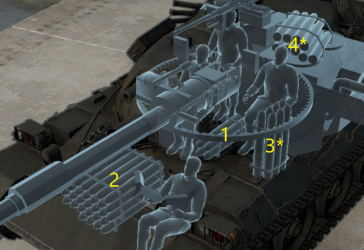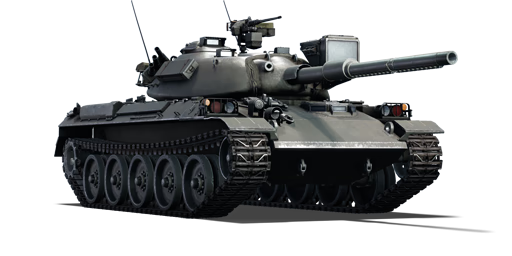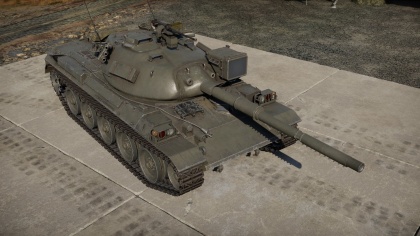Type 74 (E)
Contents
| This page is about the Japanese medium tank Type 74 (E). For the premium version, see Type 74G. |
Description
The Type 74 (E) is a rank VI Japanese medium tank
with a battle rating of 9.0 (AB/RB/SB). It was introduced along with the initial Japanese Ground Forces tree in Update 1.65 "Way of the Samurai".
General info
Survivability and armour
Armour type:
- Rolled homogeneous armour
- Cast homogeneous armour (Gun mantlet)
| Armour | Front | Sides | Rear | Roof |
|---|---|---|---|---|
| Hull | 40 mm (74°), 80 mm (65°) Front glacis 80 mm (57°) Lower glacis |
35 mm (44°) Top 30 mm, 10 mm (55-56°) Bottom |
20 mm Top 25 mm (47-48°) Bottom |
25 mm |
| Turret | 132 mm (27-53°) Turret front 200 mm (34-73°) , 150 + 170 mm (0-44°) Gun mantlet |
132 mm (5-57°) Front 67 mm (37-47°) Rear |
37 mm (17-39°) | 67 mm Front 37 mm Rear |
| Armour | Sides | Roof | ||
| Cupola | 80 mm | 80 mm |
As with most medium tanks of the rank, the hull of Type 74 is only capable of stopping some autocannon fire and has very vulnerable sides, however, the turret armour of Type 74 is closer to American and British turret armour level. While it's unlikely to stop most APFSDS, it is very likely to deflect stray APDS and APHE. Light tanks will likely have to get close and personal to penetrate it, as penetrating cupola even with APDS belt is a challenge due to its size.
The advantage can be kept even when creeping onto the enemy high ground by using hydropneumatic suspension before driving uphill to not allow the enemy to fire at the roof. In rare cases, the tank can "duck" behind cover to hide at least a portion of the turret from enemy fire.
Notes:
- Suspension wheels and tracks are both 20 mm thick.
- The Type 74's hydropneumatic suspension means it could vary the sloped angle of its armour towards the enemy.
- Hull roof is rated to be 25 mm effective against HE.
Mobility
| Game Mode | Max Speed (km/h) | Weight (tons) | Engine power (horsepower) | Power-to-weight ratio (hp/ton) | |||
|---|---|---|---|---|---|---|---|
| Forward | Reverse | Stock | Upgraded | Stock | Upgraded | ||
| Arcade | 59 | 9 | 38 | 1116 | 1,660 | 29.37 | 43.68 |
| Realistic | 54 | 8 | 637 | 870 | 16.76 | 22.89 | |
Armaments
Main armament
| 105 mm L7A3 | Turret rotation speed (°/s) | Reloading rate (seconds) | |||||||||||
|---|---|---|---|---|---|---|---|---|---|---|---|---|---|
| Mode | Capacity | Vertical | Horizontal | Stabilizer | Stock | Upgraded | Full | Expert | Aced | Stock | Full | Expert | Aced |
| Arcade | 50 | -6°/+9° | ±180° | Two-plane | 22.8 | 38.1 | 38.4 | 42.5 | 45.18 | 8.7 | 7.7 | 7.1 | 6.7 |
| Realistic | 14.3 | 20.3 | 20.4 | 22.6 | 24.0 | ||||||||
Ammunition
| Penetration statistics | |||||||
|---|---|---|---|---|---|---|---|
| Ammunition | Type of warhead |
Penetration @ 0° Angle of Attack (mm) | |||||
| 10 m | 100 m | 500 m | 1,000 m | 1,500 m | 2,000 m | ||
| M735 | APFSDS | 353 | 350 | 342 | 333 | 322 | 312 |
| Type 75 | HESH | 127 | 127 | 127 | 127 | 127 | 127 |
| Type 91 | HEATFS | 400 | 400 | 400 | 400 | 400 | 400 |
| Type 93 | APFSDS | 405 | 403 | 396 | 388 | 378 | 370 |
| Shell details | ||||||||||
|---|---|---|---|---|---|---|---|---|---|---|
| Ammunition | Type of warhead |
Velocity (m/s) |
Projectile Mass (kg) |
Fuse delay (m) |
Fuse sensitivity (mm) |
Explosive Mass (TNT equivalent) (g) |
Normalisation at 30° from horizontal |
Ricochet | ||
| 0% | 50% | 100% | ||||||||
| M735 | APFSDS | 1,501 | 3.7 | N/A | N/A | N/A | +1.5° | 76° | 77° | 80° |
| Type 75 | HESH | 760 | 10.8 | 0.4 | 0.1 | 2,700 | +0.0° | 73° | 77° | 80° |
| Type 91 | HEATFS | 1,150 | 10.5 | N/A | 0.1 | 1,271 | +0.0° | 65° | 72° | 77° |
| Type 93 | APFSDS | 1,501 | 3.4 | N/A | N/A | N/A | _._° | 78° | 80° | 81° |
| Smoke shell characteristics | ||||||
|---|---|---|---|---|---|---|
| Ammunition | Velocity (m/s) |
Projectile Mass (kg) |
Screen radius (m) |
Screen deploy time (s) |
Screen hold time (s) |
Explosive Mass (TNT equivalent) (g) |
| M416 | 730 | 11.4 | 20 | 5 | 25 | 50 |
While gun is relatively equal to one of other nations, the ammunition and amount of supplement tools of type 74 is exceptional.
In general, it has all the same shell types of NATO tanks, but instead of APDS it's stock ammunition is APFSDS, which is superior to top shell of Leopard A1A1, and top APFSDS of type 74 can put some rank VII APFSDS to shame in terms of penetration and damage, both flat and angled hit.
Type 74 also has laser rangefinder, which makes it really easy to check aim in RB, compared to tanks it fights in down-tiers and sometimes even in up-tier.
The gun depression is the only real disadvantage, forcing operator to use hydropneumatic suspension. Main issue is that if chassis got damaged while tank was shifting, it will refuse to work and tank might get stuck in awkward pose, being unable to aim at opponents, however usually enemies aim to kill instead of just disabling type 74.
Ammo racks

| Full ammo |
1st rack empty |
2nd rack empty |
3rd rack empty |
Visual discrepancy |
|---|---|---|---|---|
| 50 | 15 (+35) | 6 (+44) | 1 (+50) | Yes |
Optics and night vision
| Type 74 (E) Optics | ||||||
|---|---|---|---|---|---|---|
| Type of optic | Magnification | Night Vision Devices | ||||
| Image Intensifier | Thermal Imager Resolution |
Notes | ||||
| Resolution | Light Mult | Noise Level | ||||
| Gunner's Sight | X8 - X16 | 800X600? | ? | high | Not Fitted | Only useable with an upgrade |
| Commander's View | X6 | 800X600? | ? | high | Not Fitted | Only useable with an upgrade |
| Driver's View | X1 / 3PV | 800X600 | ? | high | Not Fitted | Only useable with an upgrade |
Machine guns
| 12.7 mm M2HB | ||||
|---|---|---|---|---|
| Mount | Capacity (Belt capacity) |
Rate of fire (shots/minute) |
Vertical guidance |
Horizontal guidance |
| Pintle | 1,000 (200) | 576 | -10°/+40° | ±120° |
| 7.62 mm Type 74 | ||||
|---|---|---|---|---|
| Mount | Capacity (Belt capacity) |
Rate of fire (shots/minute) |
Vertical guidance |
Horizontal guidance |
| Coaxial | 5,500 (250) | 500 | N/A | N/A |
While it's not recommended, it's still possible to use 12.7 mm to fight light tanks like AUBL/74 HVG or Rooikat Mk.1D and most SPAA tanks at <100 m range.
Do not charge them with just the MG, especially at long range, as even poorly armored rank V light tanks can survive frontal MG fire long enough to disarm and explode Type 74 - let them come to you, hit them with the main gun and ensure they never move again by firing at their sides or flat parts, while hiding yours.
Any melee oriented light tanks like BMP-2 or Warrior with add-on armour will have enough armour to absorb the MG fire and will greet Type 74 back with point blank ATGM attack, which machine guns will be unable to stop at such range.
Usage in battles
As the Type 74 is very comparable to the Leopard 1 Series, especially the Leopard A1A1, it is recommended to play them in the same fashion as such. In a Hit & Run tactic.
The additional benefits of the Type 74 over the Leopard A1A1 are:
- A top mounted .50 which can be used to deal with soft targets swiftly or damage gun barrels or track opponent tanks.
- Hydropneumatic suspension to:
- Increase gun depression or elevation.
- Improve traverse rate off- and on road.
- Could vary the sloped angle of its armour towards the enemy.
- Stronger turret armor
- Night vision spotlight
- Stock APFSDS (M735)
- Which in its own right is stronger than the leopard's APFSDS (DM23)
- Strongest 105 mm APFSDS in-game (Type 93)
With all the additional benefits out of the way, it shouldn't be negated it's still a gen 2 MBT with barely any armor to rely upon other than the strong turret which still will be defeated by most rounds that the Type 74 will face. It is advised to make use of the terrain to your advantage in combination with the hydropneumatic suspension. The stabilizer also allows for the Type 74 to shoot on the move and due lower top speed compared to the Leopard, should be even easier to shoot on the move.
But even though armor isn't the strong suit of the Type 74, it gets an amazing choice of rounds to make use of. Even the strongest tanks should fear a stock Type 74 as it gets the M735 APFSDS, which is usually a tier IV modification for most 105 mm L7A3 carrying tanks, this gives the Type 74 a lot of one shot potential on all its targets without the need to aim towards weak spots.
In a nutshell: Use the mobility with the cannon's perfection to flank and spank enemies (But if you have to resolve to a frontal attack, the APFSDS still allows for such a playstyle). Wait and hunt for the perfect positions and kill the enemy tanks one by one, while always maintaining a good situational awareness. Patience is the key to success.
Modules
| Tier | Mobility | Protection | Firepower | |||
|---|---|---|---|---|---|---|
| I | Tracks | Parts | Horizontal Drive | Type 75 | ||
| II | Suspension | Brake System | FPE | Adjustment of Fire | Type 91 | Laser rangefinder |
| III | Filters | Crew Replenishment | Elevation Mechanism | M416 | Smoke grenade | |
| IV | Transmission | Engine | Artillery Support | Type 93 | NVD | |
Pros and cons
Pros:
- Same gun and general ammo choices as the NATO tanks
- M735 APFSDS comes stock, is free, and is better than top shell of Leopard A1A1
- Gets improved Type 93 APFSDS, which can deal frontally with anything the tank will see from any range
- A little bit more agile than the Leopard A1A1
- .50 cal machine gun proves useful against SPAAGs, as well as strafing aircraft
- Better frontal armour overall than the Leopards, ZSU-57-2 will have a much harder time defeating it from the front, can also bounce some medium tank APDS
- Hydropneumatic suspension system can give up to -12° of gun depression as well as more compatibility for terrain
Cons:
- Hydropneumatic suspension system takes time to deploy and undeploy
- Only -5° of gun depression without deploying the suspension
- 53 km/h top speed compared to Leopard A1A1's 65 km/h (however, both tanks rarely reach this speed)
History
Development
A year after the Japanese Ground Self-Defense Force (JGSDF) issued out their first post-war main battle tank, the Type 61, development started on its successor, recognizing that the Type 61 was already becoming obsolete in terms of the new Soviet tanks being produced such as the T-62. Working alongside Mitsubishi once more, they looked for a new tank design incorporating many new features introduced in tank technology. This resulted in the tank having the hydropneumatic suspension system from the U.S.-German project MBT-70, a hull shape similar to Germany's Leopard I, and the powerful 105 mm L7 gun for its main armament. Other planned features for the tank was a rotatable commander's cupola and an autoloader system for the main gun.
The first prototype arrived for testing in 1968 as the STB-1. Modifications to the design started in 1969, which saw the autoloader removed for being too complex and expensive, as well as the removal of a proposed remote-controlled anti-aircraft machine gun for the same reason. The turret design was also elongated for various design purposes. The modified prototype was labelled STB-3 and was delivered in 1971. The final prototype, STB-6, was then delivered in 1973. The tank was then accepted for service in 1974 as the Type 74 tank. Production would start in September 1975 all the way to 1989, producing 893 tanks.
Service
Due to the defensive nature of the JSDF and the absence of any hostility rising out of the Cold War, the Type 74 spent its service life in the JGSDF with no battle service. During its service life however, it was upgraded with new hardware such as infra-red imagers for night fighting and a laser rangefinder for the commander. Despite all that, the Type 74 was generally outdated in terms of specifications even before entering service, as second-generation main battle tanks like the Chieftain and T-72 outclass it and development for third-generation main battle tanks like the Leopard 2 and M1 Abrams were already underway.
The tank was to be replaced by the newer Type 90 main battle tank, but the collapse of the Soviet Union and the official end of the Cold War caused the replacement program to be halted. Today, the Type 74 still sees limited service in Japan and it was reported that 700 units were still in use in 2006.
Media
(Coarse language present)
See also
Links to the articles on the War Thunder Wiki that you think will be useful for the reader, for example:
- reference to the series of the vehicles;
- links to approximate analogues of other nations and research trees.
External links
| Japan medium tanks | |
|---|---|
| Type 97 | Chi-Ha · Chi-Ha Kai · Chi-Ha Kai TD · Chi-Ha Short Gun |
| Type 1 | Chi-He · Chi-He (5th Regiment) · Ho-I |
| Type 3 | Chi-Nu · Chi-Nu II |
| Type 4 | Chi-To · Chi-To Late |
| Type 5 | Chi-Ri II |
| Type 61 MBT | ST-A1* · ST-A2* · ST-A3* · Type 61 |
| Type 74 MBT | ST-B2* · Type 74 (C) · Type 74 (E) · Type 74 (F) · Type 74 (G) |
| Type 90 MBT | Type 90 · Type 90 (B) · Type 90 (B) "Fuji" |
| Type 10 MBT | TKX (P)* · TKX* · Type 10 |
| Other | Ka-Chi |
| USA | ▅M4A3 (76) W · ▅M47 |
| *Prototype | |





